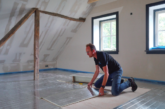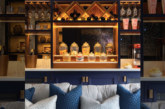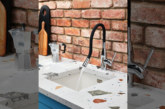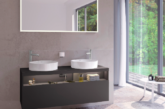
Antony Thompson, Construction Sales Director at Moores provides his tips on ensuring your kitchen specification is a sustainable one.
There is an increasing importance for housebuilders to specify products that help meet the strict industry sustainability regulations and comply with the Code for Sustainable Homes. Complete kitchens that help meet, or exceed, the required sustainability credits are therefore becoming an increasingly popular choice with manufacturers supplying more options to make meeting the criteria much easier.
There are a number of ways a kitchen can be classed as sustainable from material choice, through to manufacturing processes and the supply chain. Companies that use locally sourced materials and manufacture the entire kitchen on site reduce the product’s carbon footprint, eliminating the need for long transportation processes. For example, we use Egger wood based close to our factory in Wetherby, as well as a manufacturing process that is set up to optimise material and reduce waste.
A sustainable supply chain solution does not have to mean a compromise on overall product production or performance. Some kitchens in our Definitive collections use MFC (Melamine Faced Chipboard) doors. The MFC contains a high proportion of recycled material including our own chipboard waste which is sent back to the manufacturer for recycling. The end result is a stylish but sustainable product solution that appeals to both the end home owner and housebuilder with minimal wastage.
Accreditations
Another simple way ensure a manufacturer is producing high quality and sustainable product choices is to look out for brands and products which are FSC and FIRA accredited. We are proudly FSC certified and many of the kitchens come with the prestigious FIRA gold award which recognises both product quality and environmental performance. This means the housebuilder can rest assured that they are choosing a product that has passed rigorous testing procedures, such as ergonomic assessment and structural performance, and is also kind to the environment.
Look out for further credentials too, such as brands that are certified under BS EN ISO 14001: 2015 environmental management systems. This ensures that the companies adhere to strict regulations and help to set the standard for environmental management across the globe. There is also increasing demand for products that are BREEAM tested which can significantly add to the number of credits on the Code for Sustainable homes. For example, our ReAction Kitchen Range is manufactured in the UK and is designed to reduce, re-use, re-cycle and is responsibly sourced. It is reviewed by a BREEAM assessor and contributes 17 credits to the Code.
Low maintenance
Kitchens that are designed with longevity in mind also provide a sustainable solution for the housebuilder and an attractive feature for the home owner. They require less maintenance and no need to replace for years. Special features to help ensure a long kitchen lifespan includes a timeless design that can evolve, therefore reducing the need to replace. The sustainable features and manufacturing process does not compromise on the overall design of the kitchen. Sophisticated manufacturers will subtly integrate these processes so that home owners can still enjoy an on-trend space in their home with the extra design touches the buyer expects. For example, clever storage solutions, integrated lighting and eye catching finishes. Therefore, choosing a sustainable kitchen benefits all parties and with the number of environmentally conscious processes now available, it has never been easier to meet the required credits and regulations.








